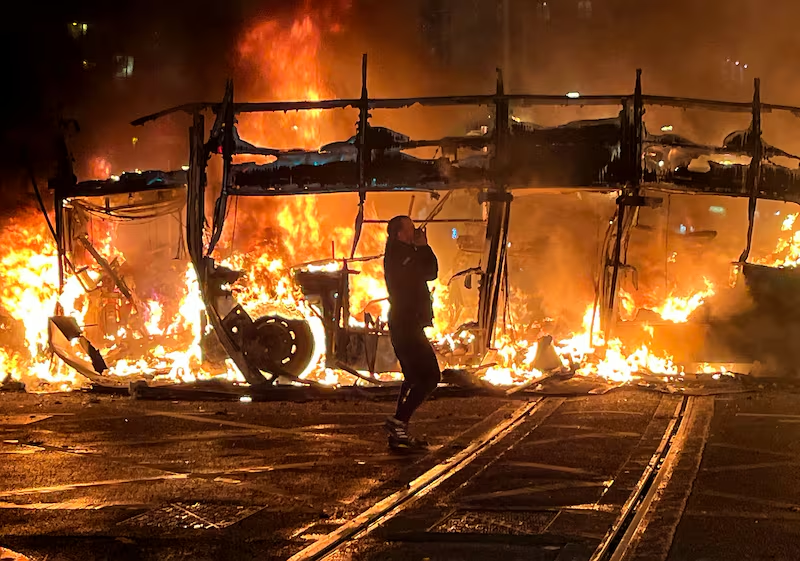Three girls – at time of writing – have died after a knife attack in Southport, a town just north of Liverpool, on Monday. Bebe King (6), Elsie Dot Stancombe (7), and Alice Dasilva Aguiar (9), were attending a Taylor Swift-themed dance class in the suburban neighbourhood when the studio was beset by someone armed with a knife. Five more children and two adults are also in a critical condition, while a 17-year-old boy remains in custody on suspicion of murder and attempted murder.
In the wake of such inexplicably horrifying events, there are always attempts to link them into broader social patterns: this is another assault in the ongoing epidemic of violence against women and girls, some have already argued. Meanwhile, others have more cynically used the tragedy for sinister political ends: to whip up religious antagonism and take to rioting on the streets of the community.
When British prime minister Keir Starmer visited the community to lay a wreath for the victims, he was heckled – it was clear, so bystanders claim, that a dark energy was already fomenting. Then, shortly into the peaceful vigil, groups began to attack police with glass and bricks, targeting a mosque in particular. Rioters burned a police van. And the local ambulance service says that, of the 39 injured police officers, 27 were hospitalised. Starmer has said the rioters will “feel the full force of law”.
The chaos and confusion inflicted by such terror provides the conditions for this kind of civil unrest. In the aftermath, there was an information black hole: who was responsible? What was the attacker’s motivation? Inevitably, rumour and conspiracy come to plug the gap – and with the catalysing effect of WhatsApp and Twitter, inaccurate information can catch on like wildfire and leads communities precisely to a place like this – whipped up into frenetic and misdirected anger. There is, for example, no evidence at the moment to suggest a connection between the attack and Islam – but the mosque became an easy target (revelatory of deeper schisms in the country, schisms Starmer cannot readily ignore).
AI panic: Artists angry that a machine is learning from their work should relax
After years of skilfully playing both sides of the ‘Boston or Berlin’ binary, we must now choose one of them
We have enough Sad Irish Girl Wanders Around Dublin novels
Michael D Higgins’s grandiose statements about military spending won’t raise Ireland’s stock
This is not unique. Tuesday night in Stockport followed patterns not dissimilar to the riots in Dublin last November. When schoolchildren were stabbed in Parnell Square on November 23rd, a general unease in Ireland transformed into unfettered wrath.

The Dublin suspect (who has since been charged and sent forward for trial) was an Algerian-born naturalised citizen, and it did not take long for agitators to learn and disseminate this information, wielding it as a rallying call for the anti-immigrant protesters waiting in the wings.
Before that moment, the “Ireland is full” coalition was vocal, and there had been a spate of arson attacks on planned direct provision centres. It was clear Ireland had its own darkness emerging on the streets – no matter its self-appointed reputation for liberal and tolerant utopia.
But it took an event such as the Parnell Square stabbing for that darkness to boil over into more widespread anti-establishment violence, with police attacked, shops looted and trams burned. Unease can turn into rage very quickly; ignoring civilian disquiet is a quick route to entrenching it.
After the Dublin riots in November, then-taoiseach Leo Varadkar said: “Today I call on us to remember who we really are.” It is a nice sentiment – a bid to remind Ireland that the anti-immigrant agitators remain a minority force in the country.
Events such as what happened in Southport on Monday are so exceptional that there is almost nothing to be drawn from them other than the simple fact that evil exists
But it was also a kind of national denial about the health of Ireland’s social fabric. Who are “we”? If Varadkar is talking to all of Ireland in that statement, then he is talking to the rioters and provocateurs too. Denying the nature of the rioters and the depth of their unhappiness is not a cure for it. If, on the other hand, he is excluding them from “who we really are”, then that is another quick path to even worse social cohesion: us, the enlightened, vs them, the thugs.
This brings us back to the recent tragedy in Southport. Starmer chastised those who “hijacked the vigil for the victims with violence and thuggery” and who “insulted the community as it grieves”. He is right to say so: sinister manipulation of tragedies for political ends is not new, but it should be roundly condemned. But such outbursts do not come from thin air – instead, like in Dublin, they are a product of a long-running unhappiness that just needs a trigger point to become something far more dangerous.
Events such as what happened in Southport on Monday are so exceptional that there is almost nothing to be drawn from them other than the simple fact that evil exists, and that evil has many manifestations. It is hard to conceive of a moral abnegation much worse than killing children as they are dancing. These things change countries.
But there are lessons to be heeded. The fault lines in Britain’s social fabric are revealed, not created, in moments such as these. Parnell Square did not radicalise 500 people in an instant; rather it generated the conditions for their protest to turn violent. Selling a story of a unified nation is nice, but if it does not cohere with reality, the problems will worsen.













